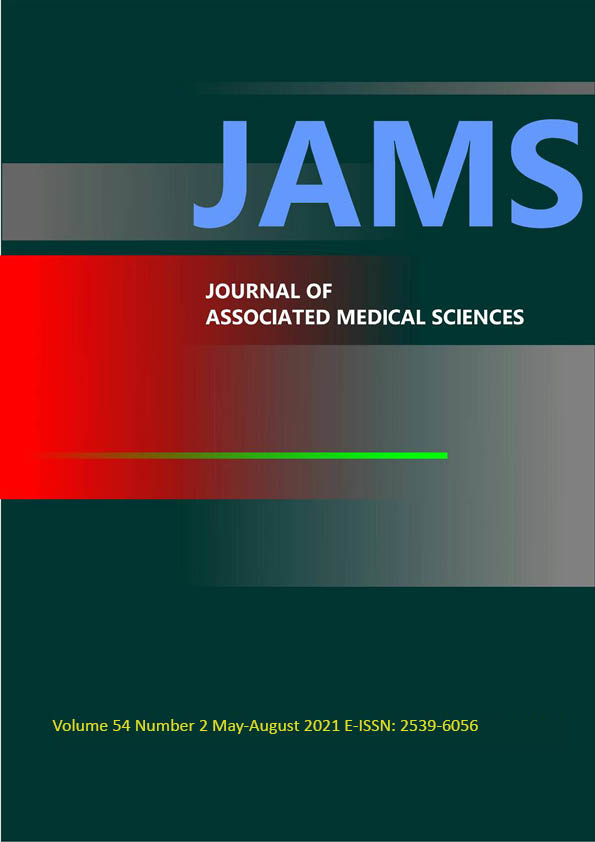A survey of radiation released from patients treated with radioiodine-131 therapy
Main Article Content
Abstract
Background: Radioactive iodine 131 (I-131) is used as an alternative to treat thyroid cancer. Patients receiving I-131 must be separated in provided hospital rooms until radiation level falls below the specified threshold. The knowledge of the amount of radiation in patient rooms along with outlying areas, together with the building's sewer systems will help monitoring and controlling the radiation hazard.
Objectives: This study was conducted to investigate the radiation exposure from ward of patients treated with I-131, and the effects upon general public.
Materials and methods: OSL devices were placed on the outer surface of sewer line and external walls of patient rooms. Accumulated radiation was measured for a period of one month.
Results: The results showed that radiation exposure from I-131 patient rooms located on the 5th floor of Srinagarind Hospital was 7.24 μSv/hr. However, the radiation detected from both sides of drainage pipe were unequal. Radiations on the 2nd, 3rd, 4th, and 5th floors were 1.70, 1.28, 2.97, and 7.24 μSv/hr, respectively.
Conclusion: It could be concluded that accumulated radiation in a single year exceeded the ICRP specified limit and poses a safety hazard for staff and general public. Recommendations to rectify the problem included increasing awareness of staff and public through warning signs, as well as adding of lead shields surrounding the patient rooms. Nonetheless, further measurements should be performed again after reconstruction.
Article Details

This work is licensed under a Creative Commons Attribution-NonCommercial-NoDerivatives 4.0 International License.
Personal views expressed by the contributors in their articles are not necessarily those of the Journal of Associated Medical Sciences, Faculty of Associated Medical Sciences, Chiang Mai University.
References
Manual on Therapeutic Uses of Iodine-131. Vienna: INTERNATIONAL ATOMIC ENERGY AGENCY.
Memon SA, Laghari N, Qureshi ST, Ahmad A, Khan A, Hussain M. Public exposure from I-131 hospitalized isolated patients in NIMRA Jamshoro Pakistan. International Journal of Cancer Therapy and Oncology. 2014; 2.
Tavakoli MB. Radioactive discharge from patients with thyroid cancer under 131l treatment and its safe disposal to the public sewer system. 2005; 9: 38-41.
1990 Recommendations of the International Commission on Radiological Protection. Ann ICRP. 1991; 21(1-3): 1-201.
Cayir D. Radioiodine Therapy of Benign Thyroid Diseases. International Journal of Nuclear Medicine Research. 2017; 4.
Kim CB, Jung JW, Jeong KH, Ahn B-C, Lee HH, Lee J. Measurements and prediction of the ambient dose rate from patient receiving radioiodine administration after thyroid ablation. Radiation Protection Dosimetry. 2012; 151(1): 158-61.
Hamizah N, Juliana M, Waidi A, Isa SNI, Ahmad Z. Surface Contamination in Skin and Room during Hospitalization of Thyroid Cancer Patient Receiving Radioiodine Ablation. IOSR Journal of Dental and Medical Sciences (JDMS). 2012; 2: 27-33.
Dehkordi F, Rasuli B, Mahmoud-Pashazadeh A. An evaluation of deviation from the international atomic energy agency-international commission on radiological protection proposed equation for calculation of radiation dose rate emanating from the patients with differentiated thyroid cancer undergoing radioiodine (I-131) therapy. World Journal of Nuclear Medicine. 2017; 16(2): 150-5.
Zehtabian M, Dehghan N, Danaei Ghazanfarkhani M, Haghighatafshar M, Sina S. Measurement of the Dose to the Family Members Taking Care of Thyroid Cancer Patients Undergoing I-131 Therapy in Nuclear Medicine Using TLD-100. Radiation Protection Dosimetry. 2017; 174(4): 541-4.
Sudchai W, Sa-Ngan-Sat A. Inlight Optically Stimulated Luminescence for Occupational Monitoring Service in Thailand. Progress in Nuclear Science and Technology. 2012; 3: 94-6.
Nagase Landauer. InLight® systems & OSL TECHNOLOGY: Nagase Landauer, Ltd.; [2020 December 23]. Available from: https://www.nagase-landauer.co.jp/english/inlight/technology.html.
The 2007 Recommendations of the International Commission on Radiological Protection. ICRP publication 103. Ann ICRP. 2007; 37(2-4): 1-332.
Release of Patients After Radionuclide Therapy. Vienna: INTERNATIONAL ATOMIC ENERGY AGENCY; 2009.


